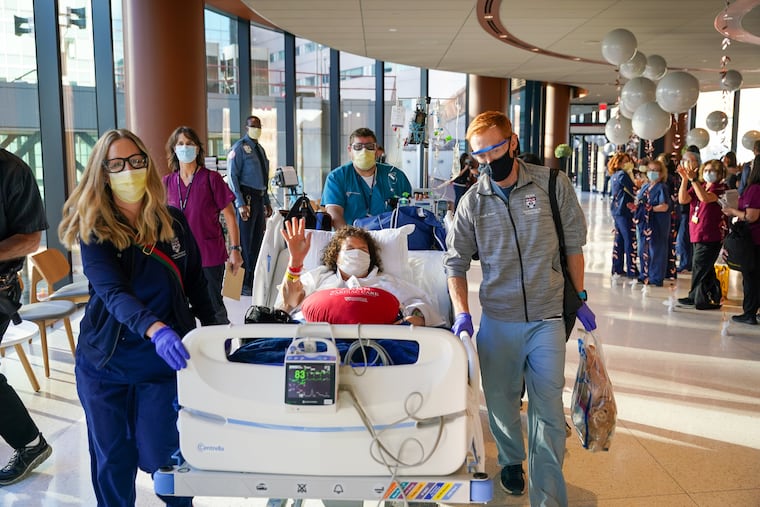Penn’s $1.6 billion Pavilion tower, its biggest yet, opens with massive patient transfer
Doctors, nurses and other staff helped transport Hospital of the University of Pennsylvania patients — including the most critical — in their beds across the University City campus.

At 9 a.m. Saturday, almost 350 Penn Medicine hospital patients were wheeled in their beds over to the newly opened $1.6 billion Pavilion tower — the largest capital project in the University of Pennsylvania’s history.
Doctors, nurses, and other staff helped transport Hospital of the University of Pennsylvania patients — including the most critical — across the University City campus.
The Pavilion boasts “1.5 million square feet, almost the same size as the newest Comcast tower,” said Kevin Mahoney, CEO of University of Pennsylvania Health System, noting that the project shared an architect in common, Norman Foster.
“It’s historic for the university, and a game changer for the hospital and the community,” said Amy Gutmann, president of the University of Pennsylvania, and President Joe Biden’s nominee for ambassador to Germany.
The design relied on input from Penn Medicine’s doctors and nurses, and even maintenance staff, as well as architecture, design, and construction professionals specializing in health care. Located in West Philadelphia, the Pavilion sits across the street from HUP and adjacent to the Perelman Center for Advanced Medicine. Bridges and tunnels connect all three facilities and their operations to one another.
Now the largest hospital in the country to achieve LEED Gold health-care certification, a green building rating system, the Pavilion “is 100% designed around the patient. They control the room, the temperature, the lighting, and even can video link with family” on a massive bedside television, and there are scanners for nurses’ and doctors’ badges to alert patients who is entering the room, Mahoney said.
The Pavilion is one of the largest hospital projects underway in the United States. The building is a 17-story facility with a helipad, 504 private patient rooms, and 47 operating rooms. The $1.6 billion price tag — roughly $1,000 per square foot — was paid for out of reserves, borrowing, and fund-raising, said Mahoney on a media tour prior to the opening. That includes a $95 million extra charge due to delays during the pandemic.
Transfer started Saturday morning
At 7 a.m. on Saturday, the Emergency Department on the west side of 34th Street closed — and the Pavilion’s Emergency Department on Convention Avenue opened, simultaneously.
“HUP will only have one active ED,” said Robin Wood, clinical director of Emergency and Observation Nursing.
Both locations, however, would remain staffed until the last patient was treated and either discharged or admitted.
Starting at 9 a.m. and continuing throughout the day, 347 patients moved from HUP — across bridges and through a tunnel — into new rooms at the Pavilion. Cardiology, neurology, and cancer patients were transferred to the Pavilion. Patients remaining at HUP’s older campus include women’s health, OB-GYN, neonatal, and general surgery.
HUP employs about 8,680 Penn Medicine workers, in addition to 3,200 physicians, and over 3,000 contract staff.
Physicians such as Frances Jensen, chair of Penn Medicine’s neurology department, said critical patients will benefit from an embedded MRI machine, and hospital rooms that can be transformed into operating theaters if necessary. “So many places were cobbled together, and this is how a modern hospital should be,” she said.
“People coming to hospitals in the 21st century will be the sickest of the sick,” Jensen said, since telemedicine and other remote treatments have become more widely adopted in helping less critical patients.
MRIs and other equipment in hybrid operating rooms allow surgeons and physicians to work side-by-side, performing image-guided surgeries with more precision, said Daniel Yoshor, chair of Penn Medicine’s department of neurosurgery, on a tour. “We’re able to integrate research as well, in real time, while we’re treating stroke victims and other patients,” he said.
Natural light flows into the operating rooms, through large windows along the hallways — creating an improved working environment.
The rooms are built with future needs in mind, with wall panels that can be swapped out for installation of new technology.
Ohio State is the only facility larger in size and with more patient rooms than the Pavilion. Stanford University’s new hospital opened in 2019 at an estimated cost of $2 billion with 368 patient rooms — compared to HUP’s 504 — and was 824,000 square feet.
Although the costs for some West Coast megaprojects are greater than HUP’s $1.6 billion, that is due to earthquake design construction increases.
Sherry Sukol, 70, was surprised to find she would be the first patient transferred to the new building.
“I got a pacemaker two days ago,” she said from her room on the ninth floor of the Pavilion, where her large screen TV broadcast the names of every nurse and doctor who entered the room automatically -- and the Hallmark channel. Sukol was diagnosed in need of a mitral valve replacement, which she had put off due to the COVID-19 pandemic.
“I never imagined I’d be the first person to enter the hospital,” she said. The pandemic took a toll on Sukol, who was isolated at home and developed agoraphobia.
“Now I’m being treated by the best doctors in the country. And I feel very brave to have done this during COVID.”